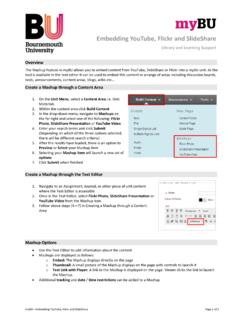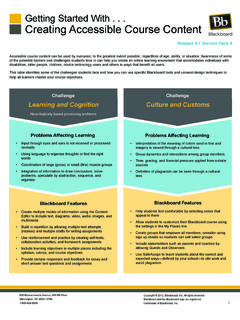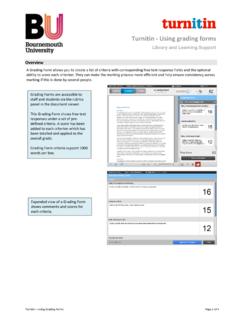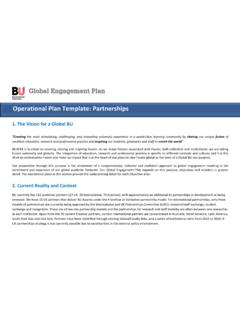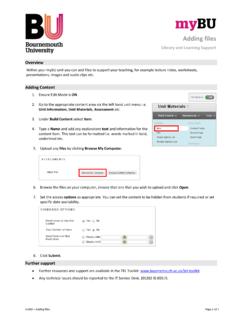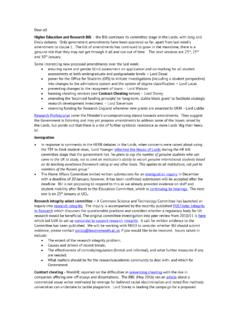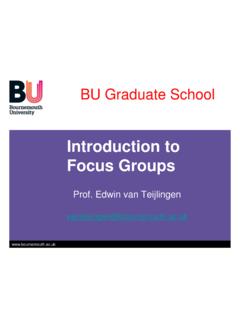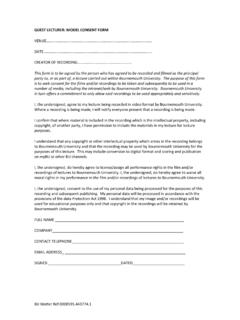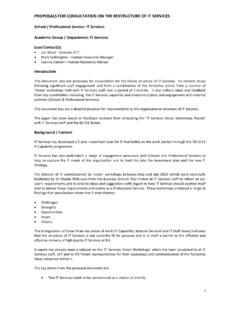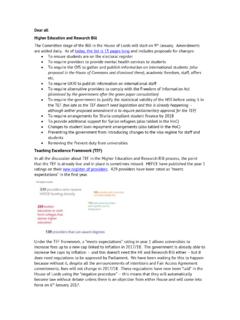Transcription of Prof. Edwin van Teijlingen - Intranet SP
1 Semi-structured interviews 3rd December 2014 prof . Edwin van Teijlingen BU Graduate School introduce various ways of conducting interviews with qualitative methods; outline strength & weaknesses semi-structured interview. Aim of this session: Addressing the why questions. We use qualitative methods to explore: Purpose Context Meaning Qualitative methods Purpose: Offer insight into how behaviours, systems & relationships change & are maintained. Understanding how organisations function. Qualitative methods Context: Interpret people s behaviours, opinions and make interactions in their normal context (social environment) Make the link between what people say they do and what they do. Qualitative methods Meaning Phenomena have meaning in a context and their meaning differs in different contexts Help to capture the ways in which people interpret events, experiences and relationships.
2 Qualitative methods A qualitative research interview seeks to cover both a factual and a meaning level, though it is usually more difficult to interview on a meaning level. Kvale (1996) The qualitative research interview seeks to describe and the meanings of central themes in the life world of the subjects. The main task in interviewing is to understand the meaning of what the interviewees say. Kvale (1996) Interview Cycle Reflecting phase Analysis phase Doing phase Planning phase delivering the question listening to the interviewee observing the interviewee s non-verbal behaviour evaluating the response probing the response recording the information formulating relevant questions designing motivating questions establishing an communicative atmosphere Identifying information gaps Preparing for the next interview Transcribing the interview Making interview records Analyzing one s own interviewer behaviour How to get your data?
3 Interview data can be collected using: Telephone Face-to-face Internet Are easy to organise. Allow for some personal contact between interviewer and interviewee. Telephones may allow people to relax and feel able to disclose sensitive information. Telephone interviews I Remember (to reduce bias): Some people may not have telephones. People often dislike intrusion of a call at home or on their mobile. Telephone interviews need to be relatively short or people feel imposed upon. Many telephone numbers not publicly listed. Telephone interviews II Telephone interviews are sometimes seen as secondary to face-to-face interviewing. The lack of visual cues may result in loss of contextual and nonverbal data and may hinder rapport building, probing, and interpretation of responses. Telephone interviews III IN-DEPTH INTERVIEWS Structured Semi-structured Unstructured Types of face-to-face interviews Interview types Structured interview: predetermined questions with fixed wording/pre-set order.
4 Open-response questions is often only difference from a questionnaire survey. Semi-structured interview: predetermined questions, but order can be modified based upon the interviewer's perception of what seems most appropriate. Question wording can be changed and explanations given; inappropriate questions for a particular interviewee can be omitted, or additional ones included. Unstructured interviews: Interviewer has a general area of interest, lets the conversation develop within this area. It can be very informal. 17 Structured Interviews Quantitative Approach (more clipboard research) Interviewer has set of predetermined questions or probes to the interviewees. Aims to Measure, seek facts, attitudes, knowledge, behaviours Finding accurate information without influences from the researcher. Little relationship between interviewer and interviewee: Minimize interaction No distractions No flexibility strict control over interview Structured Interviews Semi-structured interviews I Everyone gets the same key questions asked, but there is flexibility in how they are asked.
5 What follow-up or probing questions to use, etc. Particularly useful for exploring the views of a person towards something. Strengths Well suited for exploring attitudes, values, beliefs, and Could be good in sensitive areas. Non-verbal indicators assist in evaluating truthfulness/validity and urgency. Facilitates getting every question answered Ensures the respondent is working on his/her own Can potentially increase response Semi-structured interviews II Weaknesses Equivalence of meaning difficulties may arise Preferred social response Non-response/particular groups being unrepresented Invasion of privacy Unique characteristics of interviewee Prejudices, stereotypes, appearances and/or perceptions of researcher may alter response Semi-structured interviews III Training for semi-structured interviews Developing competency & understanding of the study.
6 Developing an awareness of potential errors or biases. Semi-structured interviews IV Unstructured interviews Also referred to as: Non-directive interviewing Non-standardized interviewing Open-ended interviewing In-depth interviewing Unstructured Interviews Find out what Important to interviewees What meaning the phenomenon under study has to them Their point of view Their understanding and experiences Types of in-depth interviews Life history / oral history Learn about events/activities that cannot be observed directly Get picture of range of settings, situations, or people. Understanding of thoughts and experiences that led interviewees to having certain opinions and feelings; Emic perspective: how local people think , what makes sense to people in their particular situations. Establish and maintain rapport with interviewee; Allow for long, seemingly rambling answers; Allow for pauses, reflections without rushing in with another question; Refrain from giving advice or making judgments on what the participant has shared; Don t inserting yourself too much into interview, drawing attention away from interviewee.
7 Semi-structured interviews: conversations with a purpose Conducting interviews is iterative process in which data collection, on-going data-analysis, reflections and generating new questions are part of a continuous comparative effort. Every interview is informed by the previous one, by the information and patterns discovered within earlier interviews. Iterative process Start with overall research question What do you know about the question? What are your assumptions about the questions and possible answers? What is the purpose of interview? What issues (or sub-questions) do you want to explore? Design interview schedule I Opening question Order and types of questions questions questions Closing question Design interview schedule II Controlling Your Biases List ways in which your characteristics might bias you in your efforts at research interviewing.
8 Then write how you might counteract these biases. And then write how these efforts to counteract your biases might themselves lead to other biases. 31 context to interviewee of the question the question meant to be: broad or narrow factual or opinion/perspective open or closed direct or in-direct neutral or loaded Types of questions Closed questions Useful for checking factual information. Otherwise avoid in semi-structured interviews. Implication: there is a reason for everything & this is knowable to interviewee; Analytical competence of ; interviewee; Motive is often a complex of factors; Many answers have complex of dimensions; Interviewee might get feeling you do not believe her (Patton 1990) Why questions not without their problems Know your research objectives/questions Get to know your interviewee Pay attention right from the start, even prior to the commencement of interview; Control your urge of self presentation Listen actively Listen emphatically Be patient Listening is a skill!
9 Don t be afraid of silence! Listening is a skill! Why probe? To let interviewee know which additional information is needed. To motivate interviewee to give more additional information. Untrained interviewer has tendency to think ahead, to think of next question in the guide, hurrying to move on. Trained interviewer listens attentively to each answer, to evaluate if answer is adequate. If not, interviewer thinks, a few seconds, about the possible cause and asks a good question to get more precise/ complete information. Probing: Tell me Clarification When interviewee uses vague or unclear language, or you just need more detail, ask for clarification. What exactly did you mean by 'XXX'? What, specifically, will you do next week? Could you tell me more about this? Examples of probing questions I Purpose When interviewee says things but you don t see why they said it.
10 Ask for justification of statement or dig for underlying causes. That s interesting, why did you say that? What were you thinking about when you said XX? Examples of probing questions II Relevance If interviewee seems to be go off-topic, you can check whether what they are saying is relevant or salient to your interview topic. Is that relevant to XX (=your key question)? How is what you are saying related to what I asked? Examples of probing questions III Completeness and accuracy Probe for more detail and check against information you have. People make genuine errors (sometimes deliberate). Is that all? Is there anything you have missed out? How do you know that is true? How does that compare with what you said before? Examples of probing questions IV Repetition Ask question again, maybe rephrase it (perhaps they did not fully understand it first time).
